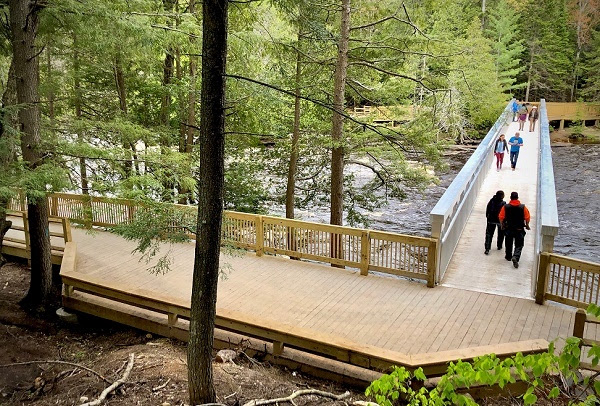Water Safety Tips to Live By
Summer is in full swing, and the water is the place to be! Though there are many ways to enjoy Michigan’s waterways – swimming, fishing, paddling, boating and more – the Michigan Department of Natural Resources wants to ensure that your first priority is safety in and around the water.
“Michigan’s waters, from the Great Lakes to our inland lakes, can be deceptively dangerous,” said Ron Olson, chief of the DNR Parks and Recreation Division. “With several drownings already reported on inland lakes and the Great Lakes this season, this underscores the importance of practicing and reviewing water safety each and every time you’re on the water.”
Although most tips apply to all situations in and on the water, there are a few distinctions between general water safety, Great Lakes beach safety and boating safety.
General water safety tips
- Before leaving home for any beach outing, check local weather reports and lake conditions.
- Always swim with a buddy or an observer on shore, regardless of swimming abilities.
- When near the water, keep small children in a U.S, Coast Guard-approved life jacket, even when playing on shore in the sand. Always watch and never turn your back to children in or near the water.
- Have a U.S. Coast Guard-approved personal floatation device readily available in case you or another swimmer needs help.
- When visiting a state park, swim in buoyed swim areas. These areas are equipped with additional safety features, such as buoys or markers that identify water depth less than 5 feet (inspected approximately every two weeks), a beach flag warning system (found in buoyed swim areas in state parks along the Great Lakes) and rescue equipment. It’s important to remember that not all state parks have designated swim areas.
- Avoid swimming near the outlets of rivers – either upstream from the outlet or where there are “no swimming” signs – because these currents can be extremely hazardous. Swimmers can be quickly swept out into the Great Lakes.
- Swimming near moored or anchored boats? Boats coming and going can create turbulent water strong enough to exhaust even strong swimmers.
- Especially in the spring and fall, please be cautious of cold-water temperatures. Sudden immersion and/or sustained time in cold water can cause cold shock, making it hard to breathe and increasing your risk of drowning.
- Keep in mind that DNR staff start removing swim buoys, beach warning flags and other visual markers that denote buoyed swim beaches at state parks along the Great Lakes after Labor Day.
- Please be aware that there are no beach guards in state parks. Visitors must swim at their own risk and are asked to always prioritize safety.
Great Lakes beach safety tips
- If you get stuck, remember these important steps: flip, float and follow. Flip over to get your mouth out of the water, float by filling your lungs with air and follow the current to determine where it’s taking you. Once you establish where the current is taking you, swim perpendicular to the current to get out of it.
- When you arrive and throughout the day, check beach flags in buoyed swim areas (double red flags = water access closed, red flag = high hazard, yellow flag = medium hazard, green flag = low hazard) in state parks along the Great Lakes. By law, you cannot enter the water from the beach when double red flags are flying or if otherwise directed. Please note that different flag systems are used at non-state park beaches.
- Do not swim near piers and breakwalls because dangerous structural currents can form.
- During certain weather conditions, the force of water and waves crashing over the surface can easily wash someone off a pier.
Boating safety tips
- Wear a U.S. Coast Guard-approved life jacket, especially when kayaking, canoeing and stand-up paddle boarding.
- If boating (or fishing) alone, wear a life jacket, tell someone on shore where you’re going and when you plan to return and schedule a check-in time.
- Make sure you’re boating with a sober operator who has completed a boater safety course approved by the National Association of State Boating Law Administrators.
- Before you leave shore, ensure your vessel is in good operating condition and packed with a life preserver for each person on board, a fire extinguisher, tow lines, a throwable flotation device, anchors, a communication device and a basic first aid kit.
- Jumping in the water from a boat? Make sure the motor is off before getting into the water. Always swim a safe distance away from the motor and stay in direct communication with the operator so they are aware of where you are.
- If you are swimming or boating in unfamiliar water, ask DNR staff or locals about the conditions, depth and any obstructions (such as sand bars, rocks or fallen trees) that may be hiding under the surface.Contact: Pat Whalen (DNR Parks and Recreation Division district supervisor), 269-838-1196, or Cpl. Jill Miller (DNR marine and boating safety specialist)
In Michigan, boaters born after , 1996, and most personal watercraft (Jet Ski) operators who operate a vessel in Michigan must have a boater safety certificate, and children under the age of 6 must wear a U.S. Coast Guard-approved life jacket while riding on the open deck of any vessel while underway.
Learn more about these and other top tips, including information on the benefits of buoyed swim areas, the beach flag warning system, how to spot (and escape) Great Lakes currents and more at Michigan.gov/BeachSafety.





